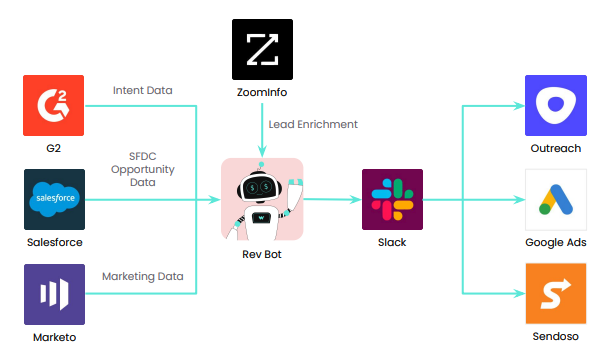As someone who’s worked in the integration and automation industry for many years, I can confidently say that there’s no “single, best way” to justify the use of integration and automation at every company.
However, leveraged effectively, integration and automation technology often yields similar benefits for companies across industries, geographies, and sizes.
Some of these benefits are well known—cost savings, for example—while others are thought of less often but are no less important.
To help you understand the top benefits integrations and automations enable, and to help you make the business case for this type of technology, I covered their 5 most powerful value propositions during my inaugural Coffee with Massimo webinar series.
You can read on to learn more about each of the benefits I presented.
1. Reduce costs and increase efficiency
Integrations and automations can be used to streamline any number of business processes, allowing them to operate faster, produce less human errors, and minimize the amount of manual data entry that needs to be performed (which is the ultimate goal).
This, in turn, leads to different types of cost savings for your business. For instance, in the case of invoice processing, you’ll be able to save on labor costs, as employees won’t have to re-key invoice data across your business applications; moreover, it saves you from the costs associated with resolving manual data entry errors in your invoices.
2. Improve the end-user experience
Your end users, which can take the form of clients, employees, business partners, students, citizens, etc., need you to provide a single, intuitive, consistent, unified, and conversational UX that’s capable of tapping into a variety of disparate backend systems. Reason being, it allows them to avoid dealing with these systems’ different and inconsistent user interfaces.
Integration and automation technology can power this demand for all kinds of scenarios.
Take the employee experience, as an example.
Your employees have access to a range of applications with fragmented user experiences, leading to confusion, duplicate efforts, and manual errors. In addition, whenever your employees want to perform actions that involve multiple applications, they’ll need to move from one to the other, maybe copying and pasting data across diverse “screens,” which, over the long run, is immensley time consuming.
Your integration and automation technology can directly address both issues by, for example, offering a platform bot in your business communications platform (like Slack or Microsoft Teams) that’s connected to your backend applications. This type of bot allows employees to access the data and functionality they need from their backend applications through a conversational, natural-language-based interface in their business communications platform.
Related: The benefits of using a process orchestration platform
3. Enable business agility and change
The pandemic has forced organizations to adjust their operations to varying degrees. Some have shifted a few of their operations to digital-only, while others have been forced to change their business model altogether.
The takeaway here is that organizations need to be able to react to changes in their surrounding business environment quickly and intelligently by adjusting their business processes.
Fortunately, integration and automation technology can help, as it allows you to tweak or redesign your integrations and workflow automation processes quickly, and in some cases, within a matter of minutes.
Notable fact: During the webinar, this business benefit was voted as the most important by attendees—receiving roughly 33% of the total votes! Given that we’re still living through a rather turbulent business environment, this result should perhaps come as little surprise.
4. Provide insights and situational awareness
While understanding historical data has its purpose, combining real-time insights from a variety of sources and making it available to your business leaders (i.e. providing them with “situational awareness”, that is, a real-time understanding of what’s going on in the business) is paramount to helping them make timely, data-driven, and business-critical operational decisions.
As an example, say your organization relies on a supplier’s raw materials for building your products. Through a real-time supply-chain dashboard, you could immediately learn when their delivery is arriving late. In response, you could move quickly in looking for other suppliers (or take other actions that minimize this disruption).
Integration and automation technology can power these real-time insights by extracting data from various sources, transforming it into a well-defined format, and feeding it to a stream analytics platform.
Then, the stream analytics platform can generate specific business dashboards for your business users. You can even build automated alerts on top of these streaming analytics platforms to immediately notify the appropriate stakeholders when certain notable, time-sensitive events take place (e.g. credit card fraud gets detected).
Related: The key benefits of data integration
5. Building differentiation via innovation
What makes organizations outperform their peers isn’t so much the tools they buy (anyone can buy from the same vendors); it’s how their tools work together.
Using integration and automation technology, you can combine your business applications, mobile apps, IoT-enabled devices, and services provided by business partners in creative and unique ways, leading you to transform your operations and gain a competitive advantage for years to come.
Workato has taken this to heart by transforming the company’s lead nurturing workflow. Here’s how it works:
1. Once a prospect looks at either a competitor’s page or one of Workato’s in G2 (a 3rd-party software review site), the automation gets triggered.
2. Rev Bot, a customized Workbot, gathers information on the lead from the company’s CRM and marketing automation platform, and it enriches the lead with additional data via a tool like ZoomInfo.
3. Rev Bot then shares the lead with the assigned sales rep in Workato’s business communications platform, where the rep can add the lead to a specific sequence in Outreach, launch Google Ads to their account, and send them a gift via Sendoso—all with the click of a button.
I could entertain you with endless examples of organizations that have demonstrated the business value of integration and automation beyond improving efficiency. And while the examples vary, these organizations have a common approach: They see integration and automation as neither a tactical tool nor a “necessary evil”, but rather a strategic capability they’ve invested in both from a technology and organizational perspective.
Now it’s your turn: See if you can build a more compelling case for strategically investing in integration and automation across your organization, keeping in mind the five types of business benefits illustrated above.



